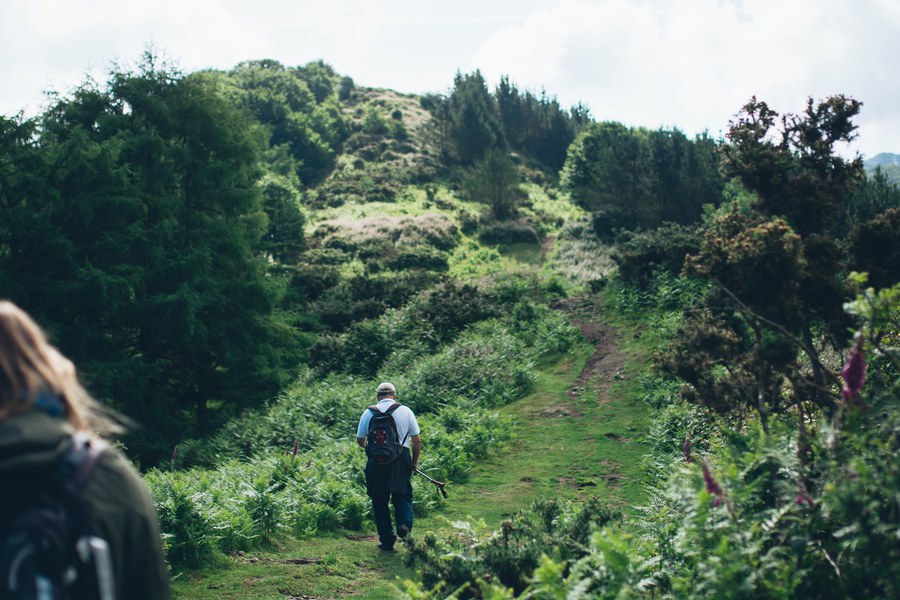Travel back in time. The Dolmen Trail.

There is a path between Elgoibar, Soraluze and Bergara that meanders among green hills. A path that runs through the mountain range from the impressive mountain of Karakate, guardian and divider of the towns of Elgoibar and Soraluze, to the hermitage of Santutxu in the Elosua neighborhood of Bergara. A natural watchtower that offers breathtaking views over the sea and the surrounding mountains. And a door to the past, because this trail is full of history.
Known as the Dolmen Trail, this route allows hikers to travel 6,000 years back in time, to prehistory. It takes us to an era between the Neolithic and the Bronze Age, a time when our ancestors abandoned nomadism for agriculture and cattle farming, and began to settle in small villages. They worked stone and later metal, bronze specifically. We do not know where they lived, but we know where they buried their dead, because they left us their funeral monuments: dolmens, tumuli, cists, and a menhir. Along with the bodies, or the ashes, they also buried various objects: pottery, tools, jewelry, and weapons.
Walking along this path is walking through prehistory, since along the 11 kilometers of the trail we will find a set of 19 megalithic monuments, dated between the year 4,300 to 800 BC approximately. Many of these monuments were discovered in 1920 by the team formed by J.M. Barandiaran, T. Aranzadi, and E. Eguren, and later excavated and investigated between 1921 and 1922. However, although they used a very advanced methodology for the time, there were not many remains found, possibly since most of the elements had been looted by then. The Basque mountains have always been the site of myths and legends, and the Karakate mountain range has not been different; in fact Barandiaran collected in his investigation the rumors about a "treasure" buried in the area. Thus, and as no excavations had taken place ever since, at the beginning of the 21st century it was decided to intervene, excavating some of the monuments again.
From this new series of excavations resulted a number of important findings. The Kerexetaegia South Dolmen stands out among them, reconstructed in 2018 after a meticulous investigation. It is possible to observe the funeral chamber under the great slab, and even appreciate part of the tumulus that covered the dolmen in its day. Another of the crown jewels is the menhir of Arribiribilleta. The monolith, 3.5 meters high, reminds us of the stone that the legendary comic character, Obelix, always carried with him. Initially and for many years it was thought that Arribiribilleta was a dolmen, or a boundary stone that marked the municipal limits. But in the excavation carried out in 2012 it was revealed that it is indeed a menhir, and in 2013 it was returned to what is believed to be its original upright position.
This route is attractive not only for the megalithic complex, but also for the landscape. The trail wanders through green slopes, plains, beech and pine forests. The ascents and descents to the peaks of Karakate, Atxolin, and Irukurutzeta take us to some of the best viewpoints in the whole of the Basque Country, allowing us to observe the Bay of Biscay on one side, at our feet the valleys of Deba and Urola rivers, and on the horizon mountains such as Anboto, the Peaks of Aia, the Aizkorri mountain range, the Mountains of Vitoria, and on a clear day, even the Pyrenees and the Picos de Europa. To locate ourselves better and have more information of our views, there is a panoramic table at the parking lot at Karakate, just at the beginning of the route from Soraluze.
The set of nature, landscape, and history make the Dolmen Trail a magical place, which now, with the arrival of good weather and organized guided tours (which by the way, are free) invite you to enjoy a pleasant day on the mountain with the whole family. The calendar and how to sign up for visits are available in this link (in Spanish or Basque). In addition, on this same website, in the Hiking section, there is a GPS track for digital media, for those who want to explore the route on their own.
